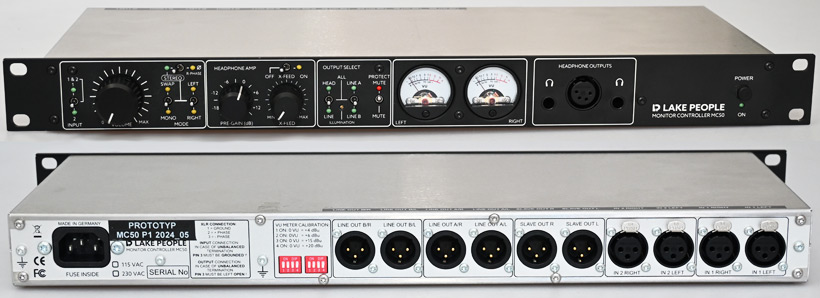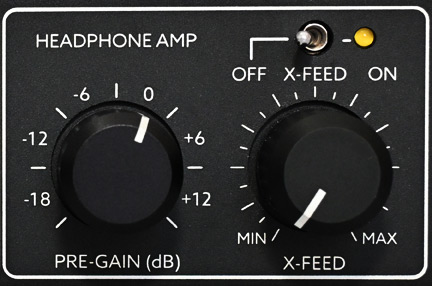Lake People MC50 and G118
Headphone amplifiers with and without monitoring matrix
Author: Peter Kaminski

We have already tested the Lake People Monitor Controller MC100, which has been available for some time. Since 2025, the MC50 has been available, which is housed in a 19-inch (1U) enclosure instead of a desktop one. The MC50 is also available as the G118 in a headphone amplifier-only version without monitor functionality.
Technology and connections
In February 2025, we already had the opportunity to test a pre-production model, which, however, was technically the same as the production model. The housing (483 x 44 x 188 mm) is made of stainless steel, and the front panel is made of three-millimeter aluminum. The integrated power supply (115/230 V, switchable internally) is generously sized and equipped with a toroidal transformer.
All inputs and outputs are balanced. The MC50 has two inputs in the form of two pairs of XLR jacks, as well as three output pairs for the two switchable stereo outputs and a slave pair through which the stereo input signal is looped. The MC100 is even better equipped in this regard, with three instead of two output pairs, a sub output, and two instead of one slave pair. The MC100 is also the only model to offer a digital input (USB-C) and an unbalanced RCA input pair. The manufacturer specifies a frequency range of 5 Hz to 100 kHz, a crossfeed of -110 dB (@ 1 kHz) and -95 dB (15 kHz), a dynamic range of min. 126 dB (A-weighted), and a THD+N of less than 100 dB.
In contrast to the MC100, the MC50 has two illuminated VU meters. The brightness can be adjusted using a small trimmer. Often, headphone amplifiers with VU meters have meters that barely move due to the set level. It is particularly noteworthy that the MC50 allows you to adjust the sensitivity of the VU meters via DIP switches on the back of the device. I would like to see this in other headphone amplifiers as well.
The MC50 uses transistors in the headphone amplifier section, with four amplifier stages. This means that even balanced headphones can be connected to the MC50 via the 4-pin XLR socket and operated in a balanced manner. This is also an advantage over the MC100, which only has a 6.3-mm jack socket, and not two like the MC50. The gain of the power amplifier is 6 dB and the output impedance is 0.125 (unbalanced) and 0.25 ohms (balanced). At 600 ohms, the maximum output level is 390 (unbalanced) or 1,220 mW (balanced), and at 32 ohms, 1,500 mW.
Operation
The front panel is divided into five sections, from left to right: The input and monitor section, headphone section, output section, meter, and headphone outputs. In contrast to the MC100, miniature toggle switches are used here instead of buttons.

In the input and monitor section (see figure above), one of the two inputs can be activated, and in the center position, both can be activated simultaneously. A high-quality RK27 potentiometer from Alps, with 41 clicks, is used for the input level (knob diameter 25 mm). To the right of the volume control, there are three switches for the monitor functions, such as: phase reversal, channel swap, or mono, as well as the selection of only the left or right channel, or both.

On the MC50, a pre-gain can also be set in the headphone section, ranging from -18 to +12 dB, so that at nominal monitoring volume, the level control is approximately in the middle of the control range. This means that you don't have to fiddle with the DIP switch inside the device and can quickly make adjustments if you want to use headphones with different impedances or sensitivity. The headphone section also offers a switchable and then adjustable crossfeed (X-FEED).
The output section features two three-way switches for line/headphones and line A/B. In the center position, both functions are active. There is also a switch for mute and a status LED in case a protective circuit is activated. Incidentally, there is a delay before the headphones are switched on, and the MC50 also features a temperature monitor to protect the device.
Headphone Amplifier G118

Let's take a look at the G118 headphone amplifier, which lacks the monitor and output selection section.

On the back, you can see that the G118 offers two balanced input pairs and one output pair. The DIP switches for meter sensitivity are also present.

The controls on the Lake People G114 are limited to input selection, level adjustment, mono/phase reversal, pre-gain adjustment, crossfeed, and mute.
Practice
Anyone who thinks the MC50 is the little brother of the MC100 is wrong because the MC50 offers different features and comes in a different housing format. I think the MC50 will appeal to more professional studios because they don't need a USB input with a monitor controller and usually don't need a sub-output either, as the bass management is usually handled differently here. But it does have meters with selectable sensitivity, adjustable pre-gain on the front panel, sophisticated transistor output stages for the headphone amplifier, a balanced headphone output, or two unbalanced headphone outputs, and the whole thing can be installed in a 19-inch rack. The MC100 is aimed more at demanding users in the home recording or project studio segment. Here, you will usually not have a 19-inch rack option in the control room table, so you may prefer a desktop case.
The workmanship of the MC50 is excellent. The MC50 can handle all headphones, whether high-impedance or extremely low-impedance, and that at the appropriate volumes.Sonically, it is very neutral. The MC100 is perhaps a touch more linear due to the use of power op-amps, and the MC50 is a bit, let's put it this way: more musical. But don't get us wrong: we're talking about nuances at the limits of perception here.
Conclusion
The Lake People MC50 monitor controller costs €1,600, while the headphone-amplifier-only variant G118 costs €1,300. This means that the MC50 monitor controller variant is not far from the price to the standard version of the MC100 without relay level control. This is not surprising since the MC50 is not a slimmed-down version of the MC100; it simply has a different technical and conceptual focus.
Now users have two different products to choose from for monitoring - or if you just need a high-quality studio headphone amplifier without monitoring functions, you can opt for the G118. In terms of sound quality and workmanship, all of these products are of the highest quality.
 How to resolve AdBlock issue?
How to resolve AdBlock issue? 



